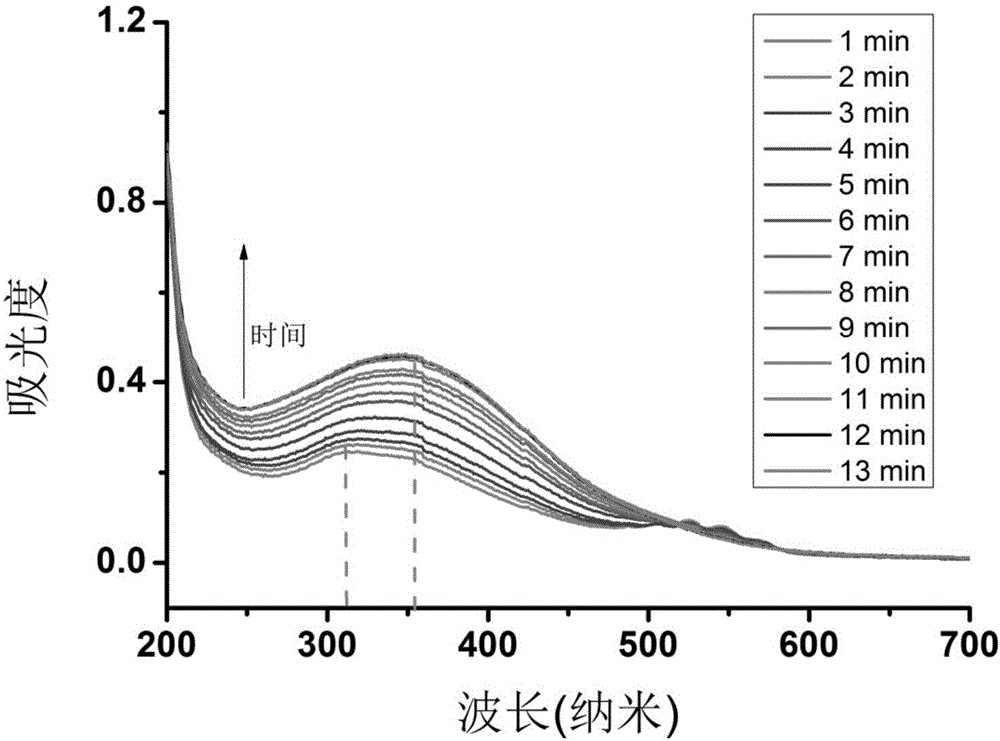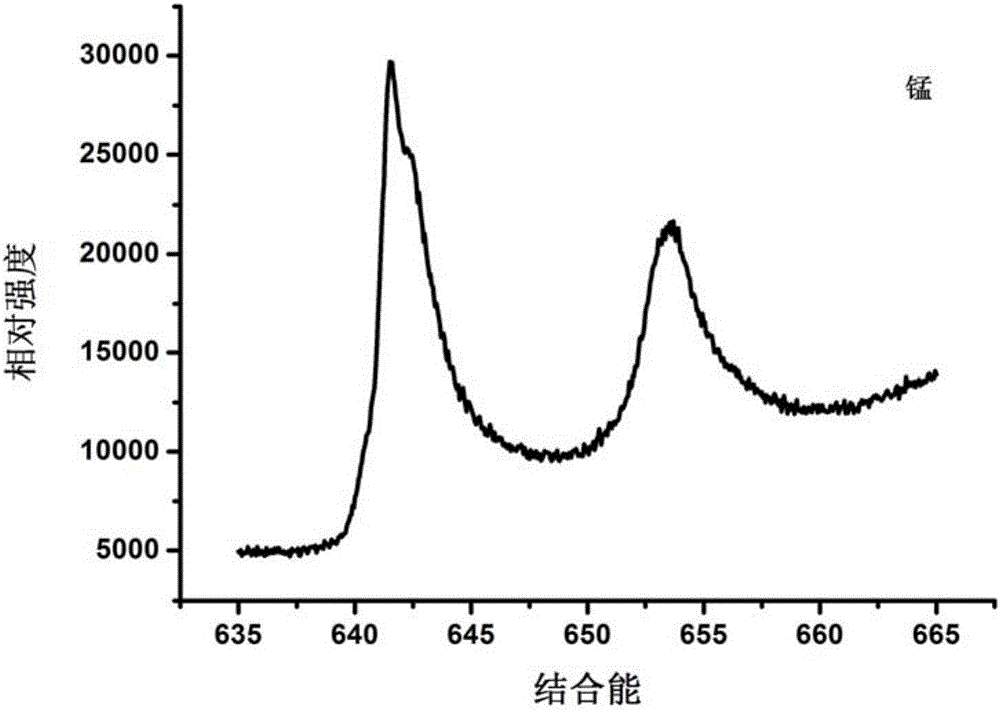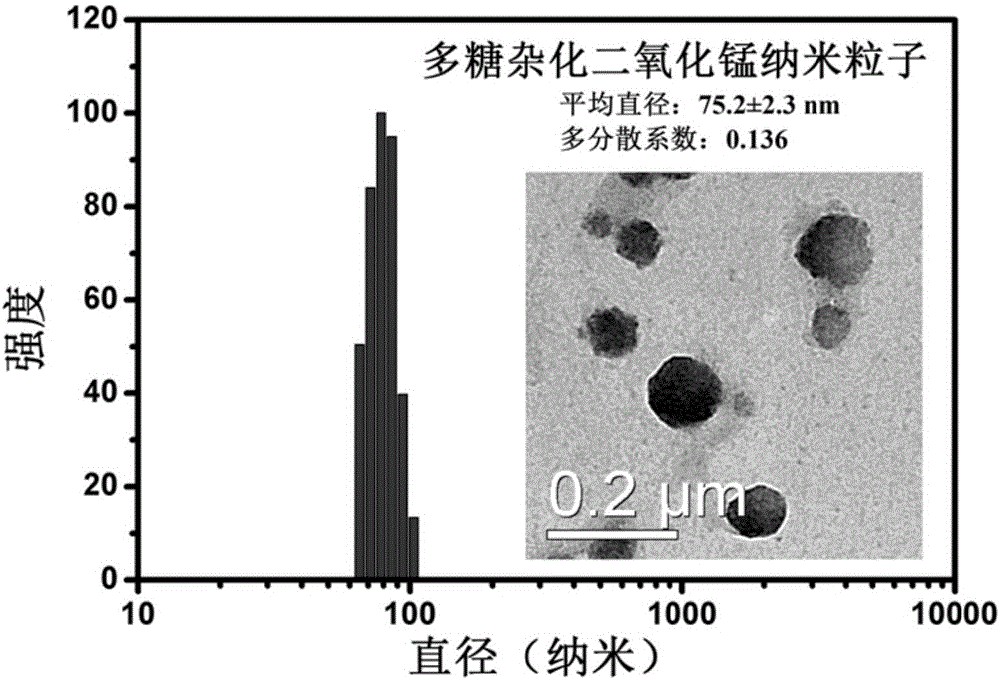Polysaccharide hybrid manganese dioxide nano-particle for magnetic resonance imaging and preparation method and application thereof
A technology of manganese dioxide and nanoparticles, which is applied in the field of biomedical materials, can solve the problems of lack of tumor targeting of manganese dioxide nanoparticles, difficulty in biodegradation of water-soluble polymers, difficulty in separation and purification and mass production, and achieve easy operation, low cost, and good biocompatibility
- Summary
- Abstract
- Description
- Claims
- Application Information
AI Technical Summary
Problems solved by technology
Method used
Image
Examples
Embodiment 1
[0028] Gently dissolve 0.1g of sodium hyaluronate (HA, molecular weight 20-50KDa) in 20mL of water at 25°C, dissolve 1mg of potassium permanganate in 5mL of water, mix the polysaccharide aqueous solution and potassium permanganate solution at room temperature Evenly, the resulting mixture was subjected to a hydrothermal reaction at 40 degrees Celsius for 15 minutes, and the ultraviolet-visible spectrogram of the solution was measured in real time by a purple-visible spectrometer, as shown in figure 1 shown. Potassium permanganate solution has characteristic absorption peaks at 315nm, 525nm and 545nm. As time goes by, the three characteristic peaks of potassium permanganate gradually disappear, and at the same time a new characteristic absorption peak appears at about 360nm, indicating that the polysaccharide hybrid Generation of manganese oxide nanoparticles. As the reaction time strengthens, the intensity of this absorption peak also continues to increase. This is because po...
Embodiment 2
[0030] Gently dissolve 1g of sodium hyaluronate (HA, molecular weight 10-30KDa) in 40mL of water at 37°C, dissolve 0.10g of potassium permanganate in 10mL of water, and dissolve the polysaccharide aqueous solution and permanganate solution at 37°C Mixed evenly, the resulting mixture continued to react at 37 degrees Celsius for 2 hours, dialyzed with pure water and then freeze-dried into powder. The valence state of the product was investigated by X-ray photoelectron spectroscopy. Tetravalent manganese can be clearly seen in the high-resolution spectrum. The characteristic absorption peak of the 2p orbital of Mn(IV) further confirmed the formation of manganese dioxide hybrid nanoparticles.
Embodiment 3
[0032] Dissolve 0.01g of sodium hyaluronate (HA, molecular weight 5-10KDa) at room temperature to prepare a solution with a polysaccharide mass fraction of 0.05%, and at the same time dissolve 0.01g of potassium permanganate in 10 mL of water, and mix the polysaccharide aqueous solution with Mix the permanganate solution evenly at 20 degrees Celsius, and continue to react the resulting mixture at 90 degrees Celsius for 12 minutes. After dialyzing and diluting with pure water, take 10 μL and drop it on a 200-mesh copper grid coated with a carbon film. After 1 minute, , blot the excess liquid with filter paper, and use JEM100CX transmission electron microscope (Japan Electronics Corporation, Japan) to observe after drying, the magnification is 50K, observe its microscopic shape by transmission electron microscope, the size is about 80nm, and dynamic light scattering The measurement results are approximately the same.
PUM
 Login to View More
Login to View More Abstract
Description
Claims
Application Information
 Login to View More
Login to View More - R&D
- Intellectual Property
- Life Sciences
- Materials
- Tech Scout
- Unparalleled Data Quality
- Higher Quality Content
- 60% Fewer Hallucinations
Browse by: Latest US Patents, China's latest patents, Technical Efficacy Thesaurus, Application Domain, Technology Topic, Popular Technical Reports.
© 2025 PatSnap. All rights reserved.Legal|Privacy policy|Modern Slavery Act Transparency Statement|Sitemap|About US| Contact US: help@patsnap.com



